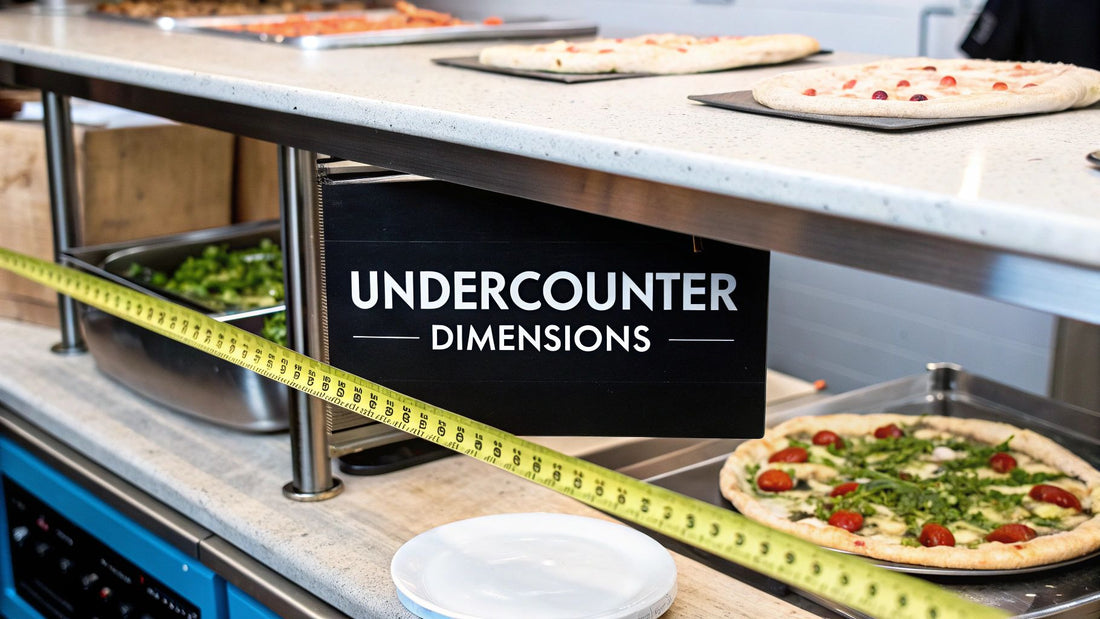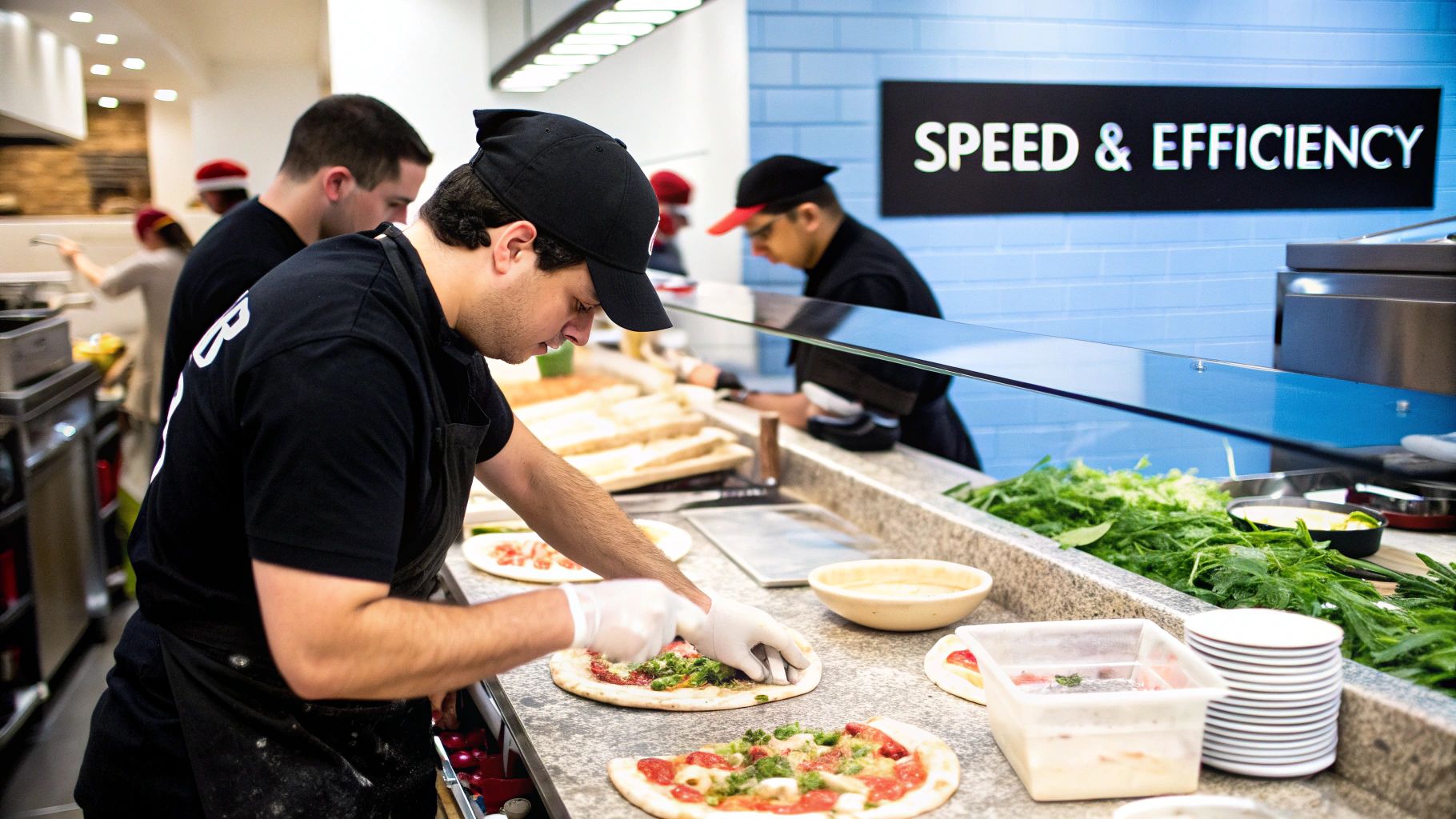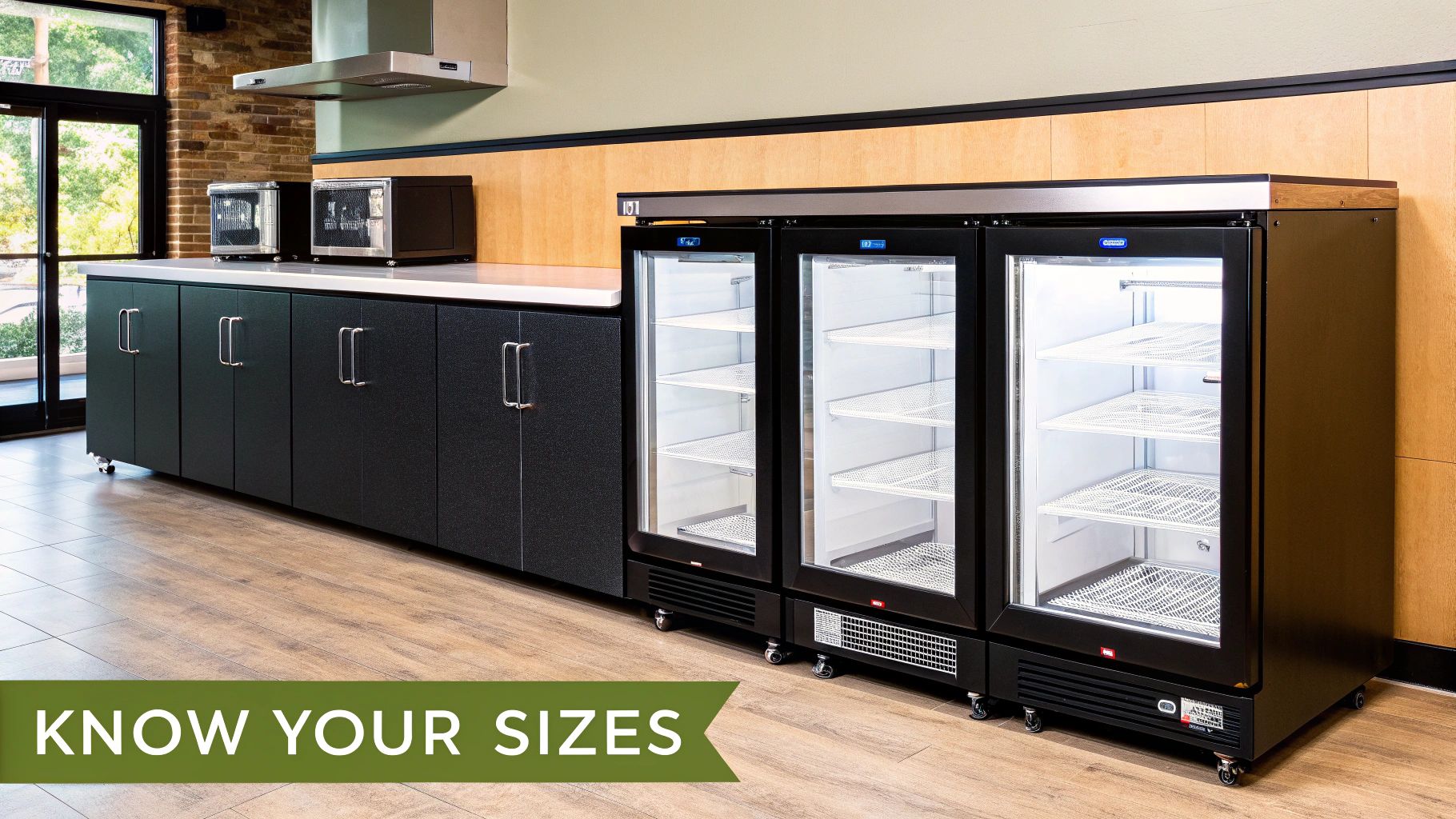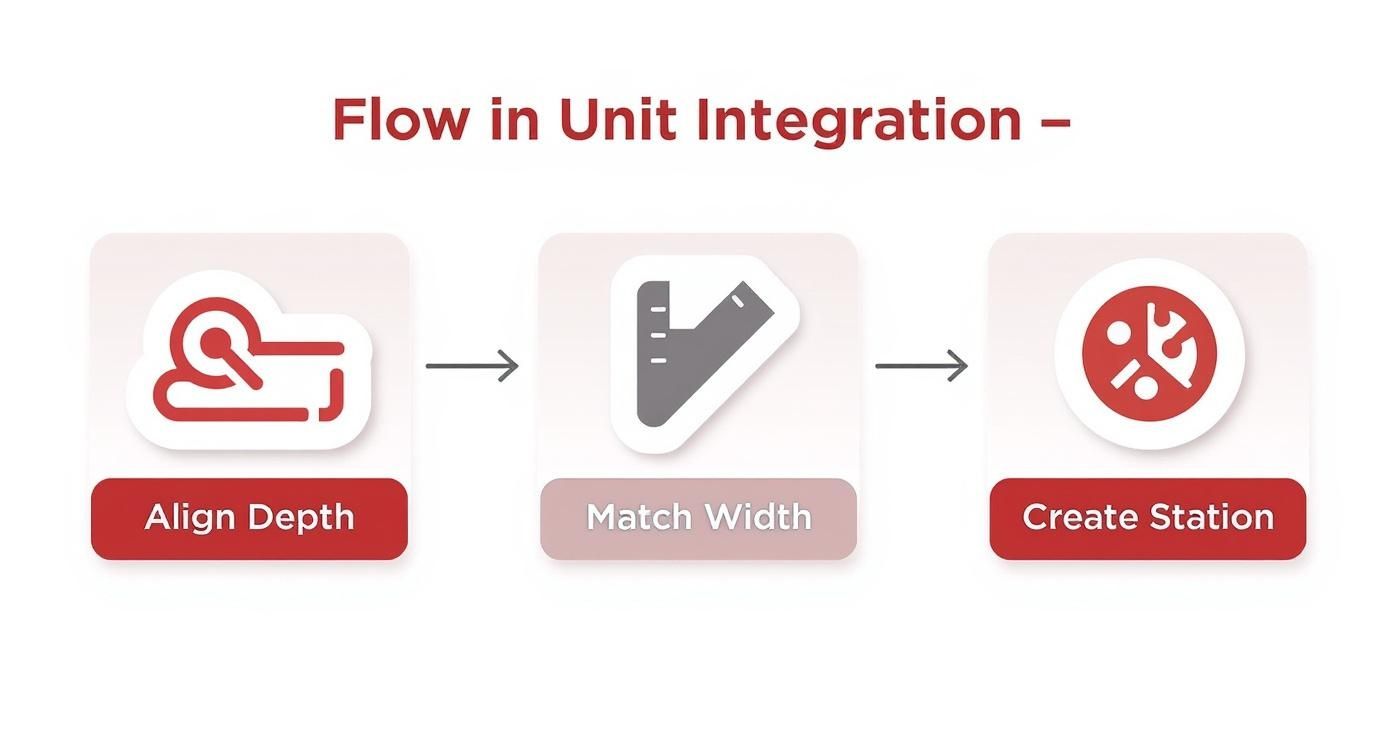
Undercounter Refrigerators Dimensions: A Pizza Shop Guide
Share
In a busy pizzeria, every second is money. The few steps between your dough station, the sauce, and the cheese can be the difference between a smooth, profitable dinner rush and a night of pure chaos. That's why getting your undercounter refrigerator dimensions right is about so much more than just making a unit fit—it’s about designing a workflow that prints cash.
Why Refrigerator Dimensions Are Crucial

Think of your pizza prep line as the engine of your entire operation. The undercounter refrigerator isn't just another appliance; it's the foundation of your whole assembly process. When its dimensions line up perfectly with your pizza prep table, you create a seamless, uninterrupted surface where every single ingredient is chilled and literally within arm's reach.
This kind of integration is everything in the pizza world, where you have to squeeze every ounce of productivity out of your kitchen space. Commercial undercounter refrigerators are built specifically to slide into tight kitchen layouts, giving you efficient cold storage without messing up your operational flow. It's no surprise the market is booming, with sales expected to jump from $12.16 million in 2025 to $16.19 million by 2035. You can dig deeper into this market growth on FutureMarketInsights.com.
The Impact of a Perfect Fit
When you nail the dimensions for your pizza prep table, the benefits hit you immediately. A perfectly sized unit completely transforms your workflow in a few key ways:
- Boosts Speed: It kills all those wasted steps, letting your pizza makers build pies faster.
- Reduces Staff Movement: Less walking and reaching means less fatigue and better focus on quality.
- Optimizes Ingredient Access: Toppings stay consistently cold and organized, which is a win for both food safety and the final product.
A correctly sized undercounter refrigerator turns your prep table from a simple counter into a powerhouse of productivity. It's the strategic core of a fast-paced, high-volume pizza operation.
At the end of the day, picking the right undercounter refrigerator dimensions isn't just about pulling out a tape measure. It's a strategic decision that has a direct line to how many pizzas you can crank out during a dinner rush, making sure your kitchen runs like a well-oiled machine.
Cracking the Code on Standard Refrigerator Sizes and Capacities

When you're staring at spec sheets, it's easy to get lost in the numbers. But undercounter refrigerator dimensions are more than just measurements—they represent real-world solutions for your pizzeria's workflow.
Think of it this way: a compact 24-inch model isn't just a small fridge. It's a dedicated, self-contained station for gluten-free ingredients, completely eliminating cross-contamination risks during a hectic dinner rush. It's a small solution to a big problem.
On the other end of the spectrum, a sprawling 60-inch or even 72-inch unit is the anchor of your main pizza assembly line. These workhorses are designed to hold dozens of ingredient pans, putting everything from pepperoni to peppers right where your pizza makers need them.
From Single Doors to Powerhouses
The width of an undercounter unit directly translates to its capacity and configuration. As you move up in size, you’re not just getting more space; you're gaining organizational power that can streamline your entire pizza prep process.
A small, single-door unit might be perfect for a quiet sandwich shop, but a high-volume pizzeria needs more muscle. The relationship between width and configuration is everything.
The real goal is to match the refrigerator's width and door/drawer layout to the complexity of your pizza menu. The more toppings you offer and the higher your order volume, the wider your unit needs to be. Simple as that.
For instance, a 48-inch unit typically gives you a two-door or four-drawer setup, which is ideal for a balanced pizza prep station with all your most common toppings. A beast of a 93-inch model might feature three doors, allowing you to separate high-use ingredients from bulk storage items like cheese blocks and sauce tubs.
Choosing the right size ensures your pizza prep flows like a well-oiled machine. You can dive deeper into this concept by exploring our guide to under-counter freezer capacity.
Common Undercounter Refrigerator Dimensions for Pizzerias
To make things easier, I've put together a quick reference table. This should help you visualize how different standard widths translate into practical setups for a busy pizza kitchen.
| Standard Width | Typical Configuration | Best For |
|---|---|---|
| 24" - 36" | Single Door | Dedicated stations (e.g., gluten-free), low-volume topping storage, or small cafes. |
| 48" | Two Doors / Four Drawers | A standard, balanced pizza prep station with common toppings for a medium-volume pizzeria. |
| 60" | Two Doors | An expanded pizza prep line, offering more space for a wider variety of popular ingredients. |
| 72" | Three Doors | High-volume kitchens needing separate zones for different ingredient types or staff members. |
| 93" | Three Doors | Maximum capacity for the busiest pizzerias with extensive menus and multiple pizza cooks. |
Ultimately, looking at these configurations helps you move past the raw numbers and start thinking about how a specific unit will actually function in your space during the Friday night rush.
Integrating Your Refrigerator and Pizza Prep Table
The holy grail for any pizzeria is that single, unified station where everything just flows. Getting the undercounter refrigerator to perfectly marry the pizza prep table sitting on top of it is the secret to making that happen. Think of it like a master carpenter fitting two pieces of wood together—a seamless join is the mark of a pro.
This isn't just about looking good, either. When your undercounter refrigerator dimensions line up perfectly with your pizza prep table, you create a workspace that’s easier on your staff's backs and dramatically speeds up the prep process. No awkward gaps, no mismatched surfaces, just pure efficiency.
Why Depth and Width Are Non-Negotiable
Pay close attention to the depth of your refrigerator; I'd argue it's the single most important measurement for a clean integration with your pizza prep table. If the fridge is too shallow, you're left with a gap at the back—a nightmare to clean and the perfect place for spatulas to disappear forever. But if it's too deep, it juts out, forcing your pizza makers to lean awkwardly over the edge for hours on end.
A flush, continuous line created by matching the depth of both the refrigerator and the prep table is a game-changer for ergonomics. It allows your crew to stand closer to their work, which seriously cuts down on back strain during a long, hectic shift.
The width is just as critical. The width of your undercounter unit is what dictates how many topping pans you can have lined up and ready to go in the prep table's rail. A wider fridge supports a bigger prep table rail above it, letting you organize more ingredients in a logical flow—sauce, cheese, pepperoni, you name it. This setup turns your prep line into a well-oiled machine that your team will thank you for during the dinner rush.
A well-planned station can make a huge difference in your kitchen's output. For more on picking the right gear, you can dive into the different types of a commercial pizza prep table in our full guide.
Key Integration Points to Consider
To get that flawless, single-unit feel between your refrigerator and pizza prep table, you need to nail these three details:
- Countertop Alignment: Make sure the refrigerator’s height, including its adjustable feet, lets it slide perfectly under the prep table’s work surface. You want it snug, without any weird gaps or unnecessary pressure on the countertop.
- Ventilation Clearance: Even a snug fit needs to let the machine breathe. The refrigerator’s vents, which are usually at the front, cannot be blocked. Proper clearance is non-negotiable for preventing overheating and keeping your pizza ingredients at food-safe temperatures.
- Workflow Accessibility: Think about how your pizza makers will actually use the unit. Do you want a swinging door or drawers? For most pizza lines, drawers are the clear winner. They give you quick, top-down access to entire pans of ingredients without needing extra space for a door to swing open.
A Practical Guide to Measuring Your Kitchen Space
I’ve seen it happen more times than I can count: a simple mistake with a measuring tape turns into a costly logistical nightmare, leaving a brand-new pizza prep line in chaos. Getting the undercounter refrigerator dimensions right from the start isn’t just about fitting a metal box into a hole; it’s about making sure your kitchen actually works when the pressure is on.
This guide will walk you through a foolproof process for measuring your space. We’ll go beyond just height, width, and depth to cover the details that really matter in a high-pressure pizzeria—the stuff that keeps your pizza prep table running smoothly from day one.
The infographic below breaks down the core idea of sliding an undercounter unit into place. It’s not about one measurement; it’s about a sequence of precise alignments that create a unified, high-performance pizza prep station.

Think of it as a puzzle. Every piece has to fit perfectly for the whole picture to come together.
The Essential Measurement Checklist
Before you even think about hitting that "buy now" button, grab your tape measure and run through this list. Missing just one of these can lead to major installation headaches or a pizza prep station that just doesn't flow right.
- Ventilation Clearance: This one is non-negotiable. Most commercial units need at least 1-2 inches of "breathing room" on the sides and back. Without it, the compressor will overheat, and you’ll be calling for a repairman sooner than you think.
- Door Swing Radius: Can the refrigerator door or drawer actually open all the way? Check for collisions with other appliances, walls, or—most importantly—a busy walkway. There’s nothing worse than a fridge door blocking traffic during a dinner rush.
- Nearby Heat Sources: Never place your refrigerator right next to a pizza oven or a deep fryer. It forces the compressor to work overtime, which spikes your energy bills and dramatically shortens the unit's lifespan.
- Floor Evenness: Is your floor perfectly level? Probably not. You’ll need a unit with adjustable legs to make sure the door seals tightly and the whole thing sits stable without rocking.
For a bigger-picture look at how all these pieces fit together into a smart layout, a guide on effective kitchen remodel planning is a great place to start.
The most accurate measurements account for the equipment's operational space, not just its physical footprint. Consider how your pizza chefs will move around and interact with the unit during your busiest hours.
By thinking through these real-world details, you'll dodge the common installation traps and set up your new undercounter refrigerator for peak performance.
How to Pick the Right Dimensions for Your Pizzeria Layout
Alright, we've covered the numbers and specs. But how do undercounter refrigerator dimensions actually translate to a real, working pizzeria kitchen? This is where the rubber meets the road—we're moving from theory to the practical, real-world scenarios you'll face every day.
Let’s start with a cozy, urban pizzeria that's all about takeout. Space is at a premium, and every inch counts. In this kind of tight layout, a single, all-in-one pizza prep table centered around a 48-inch undercounter unit is perfect. It gives you just enough refrigerated storage for your core ingredients without hogging the floor.
Scaling Up for the Big Leagues
Now, let's picture a completely different scene: a huge, high-volume restaurant with a long, dedicated pizza assembly line. It's the dinner rush, and you've got multiple chefs working shoulder-to-shoulder. This kind of operation needs a different approach—think two or even three 60-inch or 72-inch units lined up under an expansive pizza prep table. This setup creates dedicated zones for meats, veggies, and cheese, which is crucial for preventing bottlenecks and keeping that line moving like a well-oiled machine.
The key is to really look at your menu, your order volume, and how your team moves around the kitchen. Tools like an interior design bubble diagram can be a lifesaver in the early stages, helping you map out your functional zones and traffic flow before you spend a dime on equipment.
Think of it this way: your refrigerator's size should match your pizzeria's ambition. A smaller unit is great for a streamlined menu, but you'll need larger or multiple units to power a complex, high-output kitchen.
There's a reason the global undercounter refrigerator market is valued at a whopping $3.2 billion. These compact units are perfectly suited for specialized kitchens like pizzerias. And as modular kitchen designs get more popular, picking the right size is more important than ever. In fact, the market is expected to grow to $5.7 billion by 2033, a trend you can read more about on marketintelo.com.
At the end of the day, your pizza prep table is the foundation of your success. To get a better handle on optimizing your entire workspace, be sure to check out our complete guide on commercial kitchen layout design.
Tying Up Loose Ends on Undercounter Units
Even after you've picked a model, a few last-minute questions always pop up about undercounter refrigerator dimensions. Getting these details right is what separates a smooth, headache-free installation from a frustrating one.
Breathing Room and Built-for-Business Brawn
How much space do I need to leave around the fridge?
Think of it like giving your refrigerator some breathing room. Every manufacturer recommends leaving at least 1-2 inches of clearance at the back and sides for ventilation. This isn't just a suggestion; it's critical. That space lets the compressor push out heat, keeping the unit from working overtime and burning out in a hot pizzeria kitchen.
Can I just sneak a residential undercounter fridge into my pizzeria?
I see this question a lot, and the answer is a hard no. It might seem like a way to save a few bucks, but it's a mistake. Commercial-grade units are built completely differently. They have beastly compressors and tough stainless steel bodies designed to survive the heat and constant abuse of a professional kitchen.
More importantly, they're certified by safety standards like NSF. Your health inspector will be looking for that certification, and not having it can get you in hot water.
Getting the Fit Just Right
What's the standard counter height for these units?
Most commercial undercounter refrigerators are made to slide perfectly under a standard 36-inch high countertop. To make life even easier, many models come with adjustable legs, so you can tweak the height for a perfectly level, snug fit with your pizza prep tables.
Drawers are the unsung heroes of a busy pizza line. They give you that quick, top-down access to ingredient pans, so you're not bending over and hunting for things during a chaotic dinner rush.
Doors, of course, have their place. They're often better for storing bigger, bulkier items like blocks of cheese or large sauce containers. It all comes down to what makes the most sense for your kitchen's unique workflow.
Ready to build the perfect pizza station? Check out our complete lineup of professional-grade equipment at Pizza Prep Table and find the perfect fit for your restaurant. Visit us at https://pizzapreptable.com to get started.
